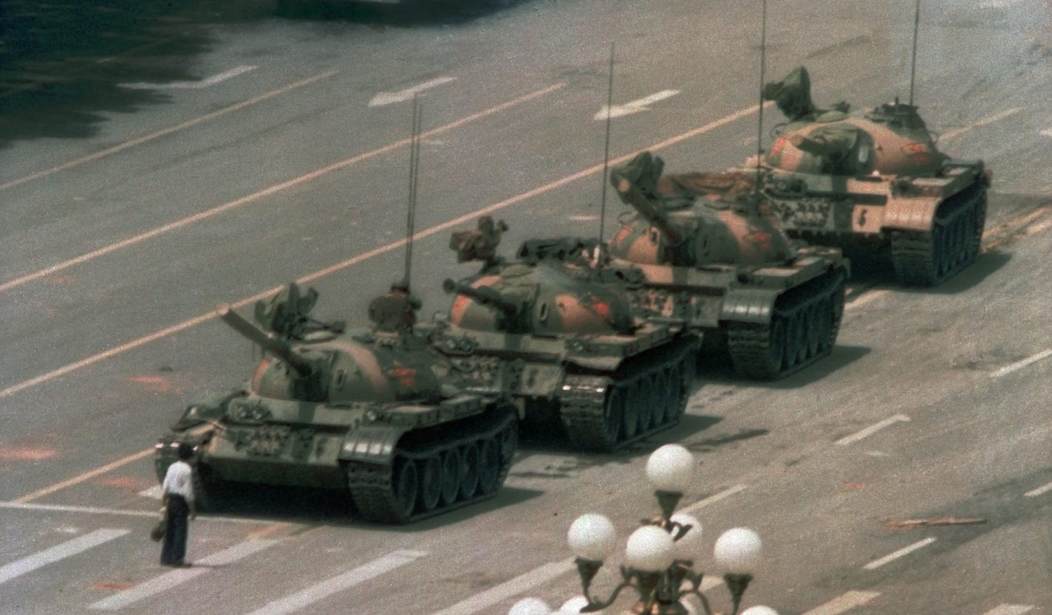Thirty years ago today, the Chinese Communist government sent troops to break up the Tiananmen Square protests in Beijing. Troops with assault rifles and tanks fired at protesters, killing between several hundred to more than 2,000, with thousands more wounded. Rather than meeting the demands of protesters for more liberal reforms and free markets, the Communist government doubled down on repression, aiming to stamp out the spirit of liberty behind the protests.
“For some time, an extremely small group of people who stubbornly promoted bourgeois liberalization cooperated with foreign hostile forces to call for revising our constitution, schemed to destroy [Deng Xiaoping’s] Four Cardinal Principles [for upholding socialism and Communist Party rule] and to tear down the cornerstones of our country; they schemed to change . . . our country’s basic political system and to promote in its place an American-style separation of three powers; they schemed to change our People’s Republic of democratic centralism led by the working class and based on the worker-peasant alliance into a totally westernized state of capitalist dictatorship,” Peng Zhen, the former chair of the Standing Committee of the National People’s Congress, said shortly after the massacre.
Foreign Affairs magazine published these remarks late last month before they became public when New Century Press, a Hong Kong-based publisher, published Zuihou de Mimi: Zhonggong Shisanjie Sizhong Quanhui “Liusi” Jielun Wengao (The Last Secret: The Final Documents From the June Fourth Crackdown).
The speeches also make clear how the lessons taken from Tiananmen continue to guide Chinese leadership today: one can draw a direct line connecting the ideas and sentiments expressed at the June 1989 Politburo meeting to the hard-line approach to reform and dissent that President Xi Jinping is following today. The rest of the world may be marking the 30-year anniversary of the Tiananmen crisis as a crucial episode in China’s recent past. For the Chinese government, however, Tiananmen remains a frightening portent. Even though the regime has wiped the events of June 4 from the memories of most of China’s people, they are still living in the aftermath.
The documents show how the Communist Party interpreted the Tiananmen Square massacre: how they doubled down on repression to fight a “foreign” menace; how they blamed someone else for Deng’s reforms; and how they sycophantically praised the current Communist leader for the oppressive response. The true story involved a home-grown protest for liberal reforms, but the Communist Party interpreted the massacre as a foreign attempt to overthrow China’s government. The resulting repression continues to this day.
Perhaps ironically, if Deng Xiaoping had chosen a less aggressive response to Tiananmen, the Communist Party might be stronger today. Zhao Ziyang, the general secretary of the Communist Party, pushed for a conciliatory approach — and lost his position for it. But Zhao claimed that the ruling party could trust the people with limited reforms and a free press, without opening the door to multiple parties. He said those changes could make the Party more legitimate, not less. Deng’s decision in favor of repression has made the Party more powerful on the surface, but also more brittle, Foreign Affairs‘s Andrew Nathan argued.
On April 15, 1989, the popular Chinese leader Hu Yaobang died of a heart attack in Beijing. He had been ousted from the Communist Party for being too liberal, but in the days after his death, thousands of students from Beijing campuses gathered in Tiananmen Square to demand the Party give him a proper funeral. As Nathan wrote, “By honoring Hu, the students expressed their dissatisfaction with the corruption and inflation that had developed during the ten years of ‘reform and opening’ under the country’s senior leader, Deng Xiaoping, and their disappointment with the absence of political liberalization.”
Party leaders debated how to respond, and the protests grew to involve as many as a million. The students in Tiananmen Square declared a hunger strike, their demands grew more radical, and demonstrators spread to hundreds of other cities across the country. The students demanded a multi-party system, an independent judiciary, the freedom of assembly, the freedom of the press, and more.
Deng declared martial law, but the protests did not stop. He ordered the use of force to start on the night of June 3.
The Tiananmen Square massacre drew international condemnation and Americans remember it today. The Victims of Communism Memorial Foundation is hosting a Rally of Remembrance on the West Lawn of the U.S. Capitol Building in Washington, D.C. The rally will include both Republican and Democratic members of Congress.
On Monday, U.S. Secretary of State Mike Pomeo released a statement commemorating the “heroic protest movement” that ended in the Tiananmen Square massacre. He condemned the Communist Party, which “tolerates no dissent and abuses human rights whenever it serves its interests.”
“Today, Chinese citizens have been subjected to a new wave of abuses, especially in Xinjiang, where the Communist Party leadership is methodically attempting to strangle Uighur culture and stamp out the Islamic faith, including through the detention of more than one million members of Muslim minority groups. Even as the Party builds a powerful surveillance state, ordinary Chinese citizens continue to seek to exercise their human rights, organize independent unions, pursue justice through the legal system, and simply express their views, for which many are punished, jailed, and even tortured,” Pompeo added.
He called on the Chinese government “to make a full, public accounting of those killed or missing to give comfort to the many victims of this dark chapter of history,” and to “release all those held for seeking to exercise these rights and freedoms, halt the use of arbitrary detention, and reverse counterproductive policies that conflate terrorism with religious and political expression.”
The Chinese Embassy in Washington, D.C., condemned Pompeo’s remarks, saying the secretary of State spoke “out of prejudice and arrogance. Under the pretext of human rights, the statement grossly intervenes in China’s internal affairs, attacks its system, and smears its domestic and foreign policies. This is an affront to the Chinese people and a serious violation of international law and basic norms governing international relations. The Chinese side expresses its strong dissatisfaction and firm opposition to it.”
The Embassy claimed that thanks to “the past four decades of reform and opening-up, China has enjoyed rapid economic and social development, continuous progress in democracy and the rule of law, flourishing culture and significantly improved standards of living. China’s human rights are in the best period ever.” The statement did not address the persecution of the Uighurs or the surveillance state.
The Party continues to refuse to recognize the Tiananmen Square massacre or the brave freedom fighters who died 30 years ago. Perhaps one day, a statue will rise in their memory. But it is not this day.
As The New York Times editorial board put it, “Even after 30 years, erasing the history of the massacre in Tiananmen Square remains an obsession of the Chinese Communist Party. To a degree, it has succeeded: The Chinese raised in the extraordinary boom times since that day often know little about what happened on June 4, 1989, or accept the official line that curbing the ‘counterrevolutionaries’ was needed to facilitate the economic miracle.”
Indeed, few Chinese know about the massacre. Perhaps no symbol of Tiananmen Square is quite as powerful as the image of the “Tank Man,” the lone protester standing in front of three tanks, about to run him down. In 2014, journalist Lisa Lim found that only 15 out of 100 students at four of China’s top universities were abler to identify the iconic Tank Man photo.
A recent survey of 239 Chinese internet users found that 37 percent of respondents said they recognized the Tank Man photo, compared with 49 percent of users across the globe. About one in six Chinese respondents correctly identified the protests at Tiananmen Square as the backdrop for the photo, according to the study conducted by Rutger van der Hoeven, a lecturer at Utrecht University in the Netherlands.
As George Orwell wrote, “Who controls the past controls the future. Who controls the present controls the past.”
The Chinese Communist Party is controlling the past, suppressing the truth about the Tiananmen Square massacre. The truth cannot be suppressed forever, but the tragedy of Tiananmen Square shows that big government tyranny can crack down on dissent for decades. Americans should remember the horrors of the 20th century and know that the threat of big government communism has not been erased from the world.
If China can kill thousands of protesters and suppress that truth from its people after 30 years, even in the internet age, government tyranny is emphatically not a thing of the past. The modern Western miracle of free-market prosperity, limited government, and broad civil rights is not the norm in human history: government oppression and poverty is. Those who encourage rejecting that miracle in favor of socialism and communism should reckon with this dark history and reconsider their support for a style of government that historically trends back toward oppression.
Follow Tyler O’Neil, the author of this article, on Twitter at @Tyler2ONeil.









Join the conversation as a VIP Member